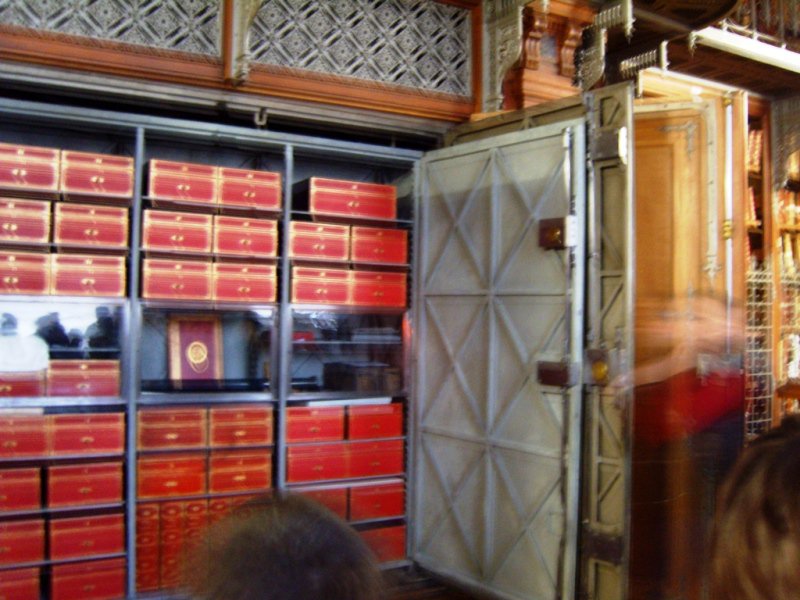Look at this photo.
Not a good picture. It took it in 2009. Back then, the only camera I had was a simple and cheap digital camera. It couldn’t really take decent pictures indoors without a flash. I couldn’t use a flash in this room. Also, I only had a few seconds to literally point and shoot.
And it’s a shame that it is the only picture I have of this place because it’s one of the most amazing things I have seen in my life.
Let me explain.
During my last two years in Paris, I had one of the best jobs one can imagine in Paris (well, except for the money, the money sucked – you know public schools, they always have tight budgets). I worked at the University of Florida Paris Research Center. It was an amazing job for many reasons. One of them is that while working there, I got to see things and visit places that most people – not even French people – will never get to see.
One of these things is the Iron Closet in the French National Archives at the Hôtel de Soubise in the historical heart of Paris.
This bad picture is of the open Iron Closet.
What is it and why does it matter? – you may be wondering.
Well, it’s an iron closet. Except that, it’s actually three iron closets encased one into the other. It was built in 1790 (although it may have been updated since… not sure though, the keys still look like very old keys). Its purpose then was to keep and protect the originals for official banknotes and other important and official documents of the time (this was in the middle of the French Revolution when the new regime was being put into place).
It’s supposed to be able to withstand fire, bombings, and more.
Its contents have changed with time and nowadays, it safeguards some of the most important documents of France.
To name a few:
- The originals of each one of the five Constitutions France has had since 1790.
- Louis XIV’s will.
- Napoleon’s will.
- The keys to the Bastille.
- The “Tennis Court Oath” (Serment du Jeu de Paume)
- The original standard meter and standard kilogram (in case you didn’t know the meter and the kilogram were invented in Paris during the Revolution).
- and more…
I didn’t see any of these.
What I got to see (because this was a history class and we were there with a purpose, not tourism – the iron closet doesn’t open for tourists) are two items that I didn’t mention above.
First, Marie-Antoinette’s last letter to her sister. She wrote it just hours before being sent to the guillotine. It was a unique and eerie experience to read the words of this woman whom you’ve “known” your whole life. Except that she suddenly ceased to be a despised historical figure and instead became a real person who is about to die and who is writing her last words to someone who is dear to her, one of the last few people who still care about her.
The second document I got to see and read was Louis XVI’s infamous diary!
Why infamous?
Because every French person knows what Louis XVI wrote in his diary on July 14th, 1789, as the Bastille was being stormed and the French Revolution started.
He wrote:
Rien
(It means “nothing” by the way)
The most famous “rien” in French history.
It’s not a legend. Louis XVI actually wrote “rien” in his diary on July 14th, 1789. I saw it with my own eyes. Even years later, typing this, remembering it, I’m still pinching myself about it. Yes, it did happen. I saw the actual diary of Louis XVI. I saw his handwriting. I saw his “rien!”
Now, I need to put things into context a little bit. For more than two centuries, this “rien” has been used to show how clueless and disconnected Louis XVI was from French people’s reality and hardships. This is how I learned it in school and I assume most other French people did too.
Now, don’t get me wrong, he was indeed quite disconnected from those (just like every aristocracy and oligarchy is). However, with that being said, there are two things to keep in mind here:
First, living in Versailles, he simply couldn’t know what was happening in the eastern side of Paris as it was happening. We tend to forget it nowadays, as we can know about anything, anywhere, pretty much in real-time, but in the 18th Century, the news didn’t go that fast. He probably wasn’t made aware of the events unfolding in Paris before the night at best. Historically, it is said that he was informed about it on the morning of the 15th.
The second reason – actually the most important one – for this “rien” is that the diary in question wasn’t a diary where the King recorded the events happening in the country or anything of the sort. It was his hunting diary. And on July 14th, 1789, Louis XVI caught nothing “rien” (or didn’t even go hunting on that day?) so this is what he wrote in his diary.
Now you know.
Discover more from liminal web
Subscribe to get the latest posts sent to your email.


